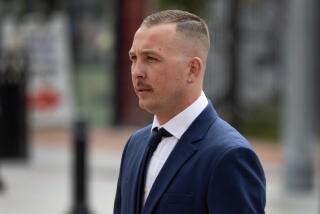Journalist snared
Eco-radicals often use sabotage in the name of what they call environmental protection. When an Earth First! activist slipped into a restricted desert canyon near Tucson in March to foil a cougar hunt, author and journalist John H. Richardson accompanied him.
Richardson says he went along to witness radical environmentalism in action for an article for Esquire. State authorities say he crossed the line. They arrested him and charged him with trespass and disabling mountain lion traps in Sabino Canyon.
Richardson says he was an observer, not a participant.
“I didn’t see what damage it could cause to the [closure] policy or a human being or the lion hunt,” he said. Besides, he asks, how else could he get the story?
In a case rife with 1st Amendment implications, the incident has opened debate about how far the press can go to cover covert activism, and how far the government can go in restricting reporters’ access to public land. If convicted, Richardson and activist Rod Coronado, the subject of his story, could face thousands of dollars in fines and up to 18 months in prison.
Richardson’s arrest underscores the challenge the media face covering radical activists who disrupt logging, attack Hummers, burn big houses and destroy animal research labs. In 1999, for example, a reporter from the Colorado Daily in Boulder was arrested while observing a predawn raid at a Vail ski resort where activists chained themselves to a truck.
The Reporters Committee for Freedom of the Press recorded about 30 arrests or detainments of journalists in the last two years. “We tend to see a lot of this in environmental-related cases,” says legal director Gregg Leslie. He says activists are “media-savvy and tend to invite the media along.”
Alex Markels, an environmental journalism fellow at the University of Colorado at Boulder, says extremist groups are secretive.
“It makes reporting these stories extremely difficult because, essentially, your subject has no face,” he says.
To tell these stories, journalists take risks. One time, the Colorado Daily reporter, Brian Hansen, debated whether to follow Earth First! members onto private land being logged. They hopped the fence. He stayed. He saw nothing. Another time, he decided to linger at the protest in Vail. “I knew if I left, there would be no way to get the story,” says Hansen, now a freelance writer. Journalists usually have the same access to land as the public. “The closure of national parks applies to everyone,” says Wallace Kleindienst, assistant U.S. attorney prosecuting the Arizona case.
The case also begets another question: Did the writer become a part of his story? “If he participated in the act, he has no claim to immunity as a journalist,” says Robert Glennon, a University of Arizona law professor. “It’s the difference between going along with someone buying drugs and seeing what went down, and trying the cocaine to see if it’s the right quality.”
Ultimately, the case may turn on a key point: What really happened that night?
What’s undisputed is this: About 3 a.m. on March 24, Richardson, Coronado and an unidentified activist crept into Sabino Canyon, which had been closed for two weeks to capture cougars. The canyon is near homes, and mountain lions had been spotted in the area.
Coronado, who served four years in federal prison for torching a mink research lab in Michigan, says he and the other activist dribbled mountain lion scent to thwart hunting dogs. The activists shadowed hunters, filmed them and disabled snares. Richardson says he only watched. Coronado agrees that that’s what happened: “He saw the unedited version of what we do.”
At dawn, a helicopter buzzed overhead. The three sprinted and stumbled on a snare. Richardson “feared being caught by the trap” and tried “to protect himself from the trap,” says a letter from his lawyer. Defense lawyers contend the closure was illegal and therefore no trespass occurred, a point the government disputes.
Federal prosecutors say in their complaint that an officer with the Arizona Game and Fish Department saw Richardson helping dismantle the snare.
Richardson and Coronado were arrested and led out of the canyon past a phalanx of reporters. The third person eluded capture. Authorities seized Richardson’s cassette tapes and put in him in jail for one night. Richardson says he took notes throughout the ordeal for his yet-to-be published article.
Richardson had, he says, intended to end his story with Coronado disappearing into the canyon’s darkness, alone.
Now, with a trial scheduled in federal district court in Tucson on June 3, it seems likely that a jury will write the story’s ending.






